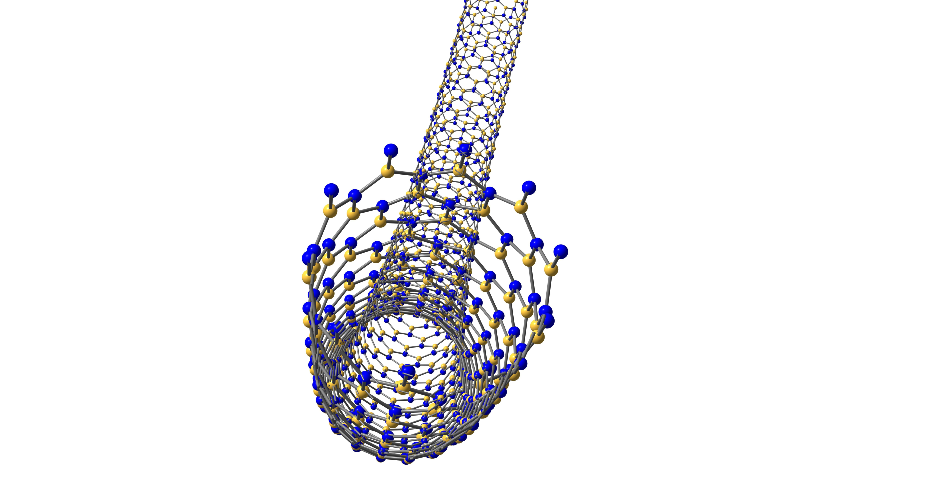Among the promising developments of nanotechnology in recent years, has been the development of the so-called bottom-up manufacturing of nanomaterials. This is the process by which materials at tiny scales and properties on the nanoscale (between 1 nm and 100 nm, or one and one hundred billionths of a meter) are manufactured through chemical growth from a material – known as epitaxy.

ImageCredit/Shutterstock: Igor Petrushenko
A growth area in bottom-up nanomaterial manufacturing in recent years has been in the development of nitrides – a class of chemical compounds of nitrogen with numerous useful properties and applications.
The growth of these compounds through epitaxy has many current and possible future applications. These are discussed below, with specific nitride compounds provided for example.
Titaniam nitride (TiN)
Sometimes known as tinite, TiN can be epitaxially grown onto a titanium substrate. It is currently used extensively in machine tooling, helping drill bits and other tool components retaining hard edges. Similar applications for TiN are within medical instruments including scalpels where hardness, sharp edges and durability are prized features.
Although it is chemically described as a ceramic due to its highly ordered lattice structure, TiN’s possible future applications apply the material as a metal. In microelectronics, thin films of TiN are used for simultaneous conduction and diffusion. In this way, TiN can be used in place of the more common silicon (Si) compounds in consumer electronics.
A future application of TiN could be in bioelectronics, medical implants where its strong biostability combined with conductivity is a significant advantage.
Lithium nitride (Li3N)
Li3N is a relatively new nitride compound which can only be manufactured epitaxially. It has been under investigation as a possible application in hydrogen gas absorption, which could have subsequent applications in the development of hydrogen fuel cells for energy generation.
Gallium nitride (GaN)
GaN is a semiconductor material being used in light-emitting diodes (LEDs) for the last three decades. It is highly valued in this application due to its ability to emit violet light at a wavelength of 405 nm.
It can be grown epitaxially using a conventional method known as molecular beam epitaxy (MBE). It is also possible to grow GaN with metalorganic vapor-phase epitaxy (MOVPE) using chemical reactions rather than physical deposition to grow materials with complex crystalline structures in multiple layers.
GaN’s traditional applications were in LEDs (in which their unique ability to emit violet light was crucial for the development of high-definition Blu-Ray entertainment), highly efficient transistors and radar technology.
Possible future applications of GaN being proposed include acting as a spintronics material for use in magnetic superconductors when doped with a transition metal like manganese (Mn). GaN nanotubes could be used in nanoelectronics, with significant applications in optical and biochemical sensing.
Boron nitride (BN)
BN is prized for its thermal and chemical stability, finding many applications exploiting these properties as a high-temperature lubricant and cosmetic additive.
Its possible future applications are in nanotechnology, where it can be produced with a similar structure to carbon nanotubes (CNTs). It can also be grown in a nanomesh structure consisting of a single layer of BN.
In this way, its applications can be similar to graphene as surface functionalization – the imparting of useful properties such as conductivity to the surface of the given substrate material. It has also been investigated for use in quantum due to its ability to conduct spintronic states. Data storage is another application of thin-film BN, where it can be applied in hard drives.
Sources:
- Arendarenko, A.A., Oreshkin, V.A., Sveshnikov, Y.N. and Tsyplenkov, I.N. (2016). Trends in the development of the epitaxial nitride compounds technology. Modern Electronic Materials, 2(2), pp.33–40. [DOI:] https://doi.org/10.1016/j.moem.2016.10.001
- Chen, P., Xiong, Z., Luo, J., Lin, J. and Tan, K.L. (2002). Interaction of hydrogen with metal nitrides and imides. Nature, 420(6913), pp.302–304. [DOI:] https://doi.org/10.1038/nature01210
- Naik, G.V., Saha, B., Liu, J., Saber, S.M., Stach, E.A., Irudayaraj, J.M.K., Sands, T.D., Shalaev, V.M. and Boltasseva, A. (2014). Epitaxial superlattices with titanium nitride as a plasmonic component for optical hyperbolic metamaterials. Proceedings of the National Academy of Sciences, 111(21), pp.7546–7551. [DOI:] https://doi.org/10.1073/pnas.1319446111
Disclaimer: The views expressed here are those of the author expressed in their private capacity and do not necessarily represent the views of AZoM.com Limited T/A AZoNetwork the owner and operator of this website. This disclaimer forms part of the Terms and conditions of use of this website.